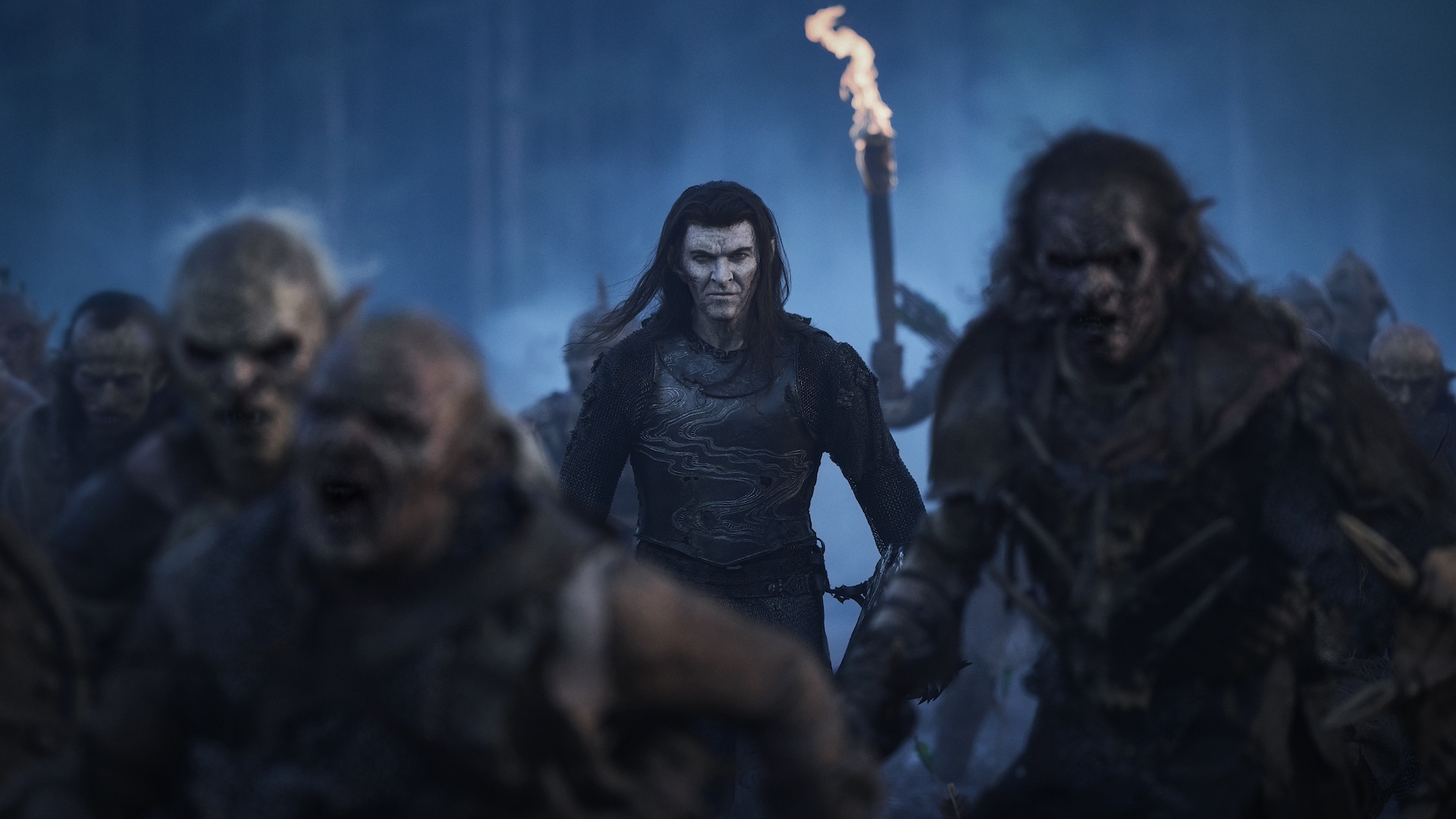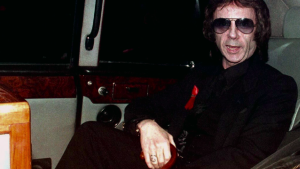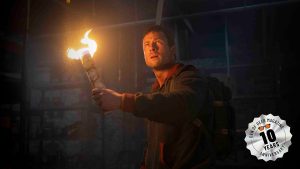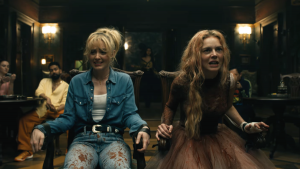
This Rings of Power review reflects the first three episodes of season two and contains spoilers for those episodes.
The Rings of Power is back! And with a triple bill of episodes to take us all firmly into Middle-earth as autumn sets in—a very appropriate time for a Tolkien-inspired adventure, considering Frodo left the Shire on his quest to destroy the One Ring on Sept. 23. Tolkien fans will be happy to hear that three episodes may be the show’s nerdiest dive into Tolkien lore yet, introducing characters and events that were previously only vague details in the writer’s extensive legendarium.
First things first: this show is still the most expensive TV series ever made, and you can see where they spent all that money up there on the screen. It is stunningly beautiful—the costumes, sets, props, production design, and location shooting (mostly in the U.K. and Europe for this season rather than New Zealand, but equally picturesque) are all a visual feast. If you felt so inclined, you could watch this with the sound off and some appropriate music in the background just for the vibes.
Assuming you do actually want to watch for the plot, story, and dialogue though, this season largely picks up where season 1 left off. Nori (Markella Kavenagh) and the Stranger (Daniel Weyman) are travelling to the Eastern land of Rhûn; Isildur (Maxim Baldry) has been accidentally left for dead in Middle-earth while Elendil (Lloyd Owen), the recently blinded Queen Míriel (Cynthia Addai-Robinson), and the other Númenoreans have returned to Númenor; Arondir (Ismael Cruz Córdova) is trying to help the displaced Southlanders who have fled the newly-created land of Mordor; Prince Durin (Owain Arthur) and his wife Disa (Sophia Nomvete) are at odds with Durin’s father King Durin III (Peter Mullan); and Elven King Gil-galad (Benjamin Walker) is deciding what to do with the three Rings of Power forged by Celebrimbor (Charles Edwards) at the end of season 1. Galadriel (Morfydd Clark) is dealing with the fallout from the revelation that her human friend Halbrand is actually the Dark Lord Sauron (Charlie Vickers) in disguise, something that she confesses to Elrond (Robert Aramayo) and Gil-galad but not, importantly, to Celebrimbor…
The experience of watching a show based on a book or books is always slightly different depending on whether you have read the book or not. If you have not read the book, you can just watch the show and enjoy the story that is unfolding (or stop watching if you’re not enjoying it). If you have read the book, however, you will inevitably spend your first viewing working out how the adaptation has changed or remained faithful to the source material. This does not necessarily mean that the adaptation is bad or ineffective; it means that because it is not what you are expecting, it can sometimes take a second viewing, or a day or two of thinking about it, to get yourself used to this new version of events.
The developing story around the Three Elven Rings here, especially in the first episode, very much falls under this category. The timeline, the order in which the various Rings are forged, and most importantly the nature and meaning of the Three Elven Rings have all been changed, and that will take a minute for book readers to get their heads around.
In Tolkien’s legendarium, the 16 Rings of Power given to Dwarves and Men are forged first, by both Sauron (in disguise as Annatar, the Lord of Gifts) and Celebrimbor working together. Gil-galad does not trust Sauron/Annatar, and nor does Galadriel, but Celebrimbor is taken in. The Three Elven Rings are created later and Sauron has nothing to do with their creation; they are designed specifically to be something untouched by Sauron. However, last of all, Sauron forges the One Ring by himself in Orodruin (Mount Doom), and although he did not help to make the Elven Rings, the One Ring is so powerful that it still has power over them.
In the show’s story, the Three Elven Rings are created first, by Celebrimbor but with help from Sauron (disguised as Halbrand). Because of that, when Galadriel reveals Halbrand’s true identity to Gil-galad and Elrond, they become suspicious of the Rings and have far more concern about them and reluctance to use them than in the books. Gil-galad and the third initial Ringbearer, Círdan the Shipwright (Ben Daniels), are won over, but Elrond takes longer. His desire to destroy the Rings all together seems designed to tie into his role in The Lord of the Rings.
Over the course of these three episodes, we can see how the show’s story will come together to match Tolkien’s more closely over time. Much of the way the show treats the Elven Rings has to do with foreshadowing events from much later in The Lord of the Rings, especially the fading of Elvendom following the destruction of the One Ring. Here, they are intended to stop a fading that is already happening, and their Bearers are much more conflicted about their use than they seem to be in Tolkien’s books, at least at this stage.
Meanwhile, Galadriel’s hesitation in telling Celebrimbor about Halbrand’s true identity looks like it will have serious consequences now that we finally get to see Sauron appear as Annatar. Halbrand’s transformation is a gorgeous and powerful scene that clearly leaves its mark on Celebrimbor, who lines up with his book counterpart, being totally taken in by Sauron. The murder of Gil-galad’s messengers who are meant to warn Celebrimbor of Sauron’s manipulations sets up some classic dramatic tension, as we must now watch Celebrimbor put all his trust in Annatar, knowing that he is actually being deceived by Sauron.
The show’s version of this story has a lot of potential and introduces some interesting conflict between the characters that will tie into the overall themes of the dangers of power, greed, and corruption that run through Tolkien’s works. Depending how it develops across the remaining five episodes, this could become a really interesting version of this tale. But it will probably take Tolkien fans a minute or two to get our heads wrapped around some of the changes and get into this slightly altered depiction of the Elven Rings.
The pacing of these episodes feels a bit sharper and more engaging than season 1, largely because the structure of the storytelling has been slightly tweaked. Rather than showing short sections of three or four different storylines in a single episode, these three episodes focus on one or two storylines each. This allows the story they focus on to develop more, a more satisfying approach that keeps the pace up a bit.
The downside to this strategy, though, is that some key plots and storylines disappear for quite a while. We don’t see Durin and the Dwarves until episode 2 and we don’t see anyone from either the Southlands or Númenor (apart from the lost Isildur) until episode 3. While we do see them in episode 3 and we get that visually impressive scene featuring one of Tolkien’s beloved giant eagles, we would like to see a bit more of the human politicking and power plays going on in the court of Númenor. Poor Míriel does not seem to be especially good at public relations, and it looks like her Chancellor Pharazôn (Trystan Gravelle) might be able to take advantage of that.
Over in the Southlands, things get off to a slightly confusing start as Bronwyn (Nazanin Boniadi) is abruptly revealed to have died some time after the end of season 1. The real-world explanation is that the Boniadi left the show, and the writers decided to kill off her character rather than re-cast. She gets a very nice funeral, and while we will miss the character, her absence might lead to a more interesting relationship and dynamic developing between her not-quite-lover Arondir and her son, Theo (Tyroe Muhafidin).
Durin, Disa, and the Dwarves are still a breath of fresh air whenever they appear onscreen, though the nature of their current storyline means even they are becoming a little bit dour. As in season 1, the series could still use just a little bit more humor, or at least dry wit, in the dialogue. It’s an epic show with big, heavy themes, and it could just do with lightening things up a little bit at times.
Luckily the Stranger and the Harfoots (Harfeet?!) can usually be relied upon to provide a bit of levity, even in the most dire of circumstances. The Stranger really seems to be discovering his inner snark, and we are keeping everything crossed that his identity will soon, finally, be confirmed so we can appreciate his character without constantly questioning who he really is. We are increasingly convinced at this point that he is probably Gandalf, but we—by which I mean me, your humble Rings of Power reviewer—were quite spectacularly wrong about Halbrand, so we’re trying to avoid being over-confident here. He is clearly extremely powerful and has the potential to do a lot of harm if he misuses that power, but that could apply to any of the Istari (the Wizards) so it’s not a clue in itself, and we should not forget that Saruman was a good guy in earlier years.
The storyline following the Stranger and the Harfoots in Rhûn is probably the most exciting so far. We have yet another mysterious villain, the Dark Wizard played by Ciarán Hinds, but more importantly, there is a really interesting story developing in which an incredibly physically powerful character is learning how to walk in the world with the two least physically powerful or imposing characters in the show, and trying his best to do good in the face of confusion and accidental sandstorms. The fact they usually talk to each other with more warmth and humor than most other characters other than Durin and Disa helps, too. And we know that we and the Stranger will soon be meeting Tom Bombadil onscreen for the first time in a major English-language production, which is quite exciting, so this storyline is really grabbing my attention so far this season.
There are some lovely little nods and echoes to other Tolkien-related things throughout these episodes. The scenes of the Stranger and Nori getting lost in a rocky landscape near Rhûn and being followed by someone or something are clearly designed to echo the opening scenes of Frodo and Sam finding their way though Emyn Muil at the beginning of The Two Towers. Luckily for them, it is Poppy (Megan Richards) who is following them, not Gollum (who is, of course, not born yet!). Isildur is on a little mini-tour of Middle-earth, taking in the Dead Marshes (also of The Two Towers fame and one of Tolkien’s most evocative landscapes) and encountering Shelob in a particularly creepy scene for those of us who are arachnophobes!
We also see hints of the Ents, who we know will be appearing later in the season—in fact, there is a general sense of echoes of The Two Towers running throughout, in a funny little meta-fictional nod to the fact this is the second season of the show. Though we did also catch an amusing reference to another franchise altogether—Gil-galad’s line in his song in which he sings “the winter comes” is entirely appropriate to the story, but does evoke Westeros more than Middle-earth.
Overall, these three episodes feel very much like a continuation of season 1, but sharpened and improved in small ways across the board. The new approach of covering only one or two stories per episode leads to some frustrating waiting for the resolution or next development in a storyline you are invested in. But it has the advantage of tightening up the pacing of each story within the episode where it appears, which makes the pacing of the show overall feel tighter, more efficient, and less baggy.
The epic feel of the story and gorgeous visuals are still big points in the series’ favor, and the acting across the board is also very good. Charles Edwards’ performance as Celebrimbor in these episodes is especially good. He really sells the character’s stress, anxiety, and vulnerability, and how completely in awe he is of Annatar’s appearance. It’s no wonder the poor guy gets taken in. Sam Hazeldine has also fairly seamlessly replaced Joseph Mawle as Adar. There is a line to subtly flag up the re-casting to the audience, and luckily the character wears heavy prosthetics that make the change fairly subtle anyway.
Because this is the second season, these first three episodes have been able to jump right into the story and draw us back into Middle-earth more quickly and effectively than the inevitable setup and exposition that was needed for the first few episodes of season 1. Having said that, there is a lot coming in season 2 that we are very excited to see and still eagerly anticipating, from Ents to Shelob to Bombadil. We’ve enjoyed these three episodes; we’re hoping to enjoy the next five even more.
The first three episodes of The Lord of the Rings: The Rings of Power season 2 are available to stream on Prime Video now. New episodes premiere Thursdays, culminating with the finale on Oct. 3.
Learn more about Den of Geek’s review process and why you can trust our recommendations here.
The post Lord of the Rings: The Rings of Power Season 2 Review – Echoes of The Two Towers appeared first on Den of Geek.







